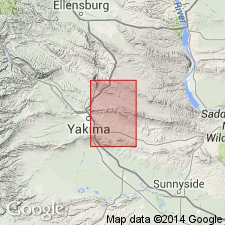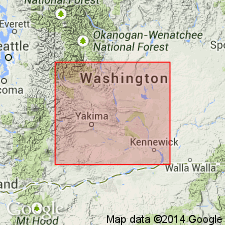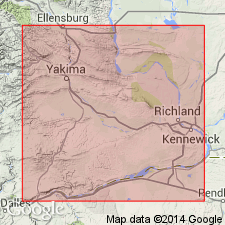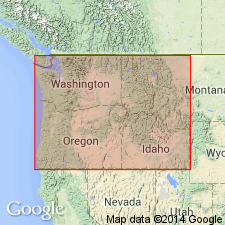
- Usage in publication:
-
- Elephant Mountain flow
- Modifications:
-
- Named
- Dominant lithology:
-
- Basalt
- AAPG geologic province:
-
- Columbia basin
Summary:
Named applied to basalt flow interstratified in Ellensburg formation [south of Elephant Mountain sec.22 and 27 T12N R20E, Elephant Mountain quad, eastern continuation of Rattlesnake Ridge, Yakima East quad, WA]. Occurs at higher stratigraphic level than Selah Butte flow (new). Average thickness about 35 ft in Yakima East 15' quad [Yakima Co, WA]; thickens eastward into widespread lava sheet in Black Rock Spring quad. Map shows Ellensburg and associated basalt flows as Miocene and Pliocene age.
Source: GNU records (USGS DDS-6; Menlo GNULEX).

- Usage in publication:
-
- Elephant Mountain Basalt
- Modifications:
-
- Revised
- AAPG geologic province:
-
- Eastern Columbia basin
Summary:
Elephant Mountain flow of Waters (1955) referred to as Elephant Mountain Basalt. Unit could be contemporaneous with either Selah Butte Basalt, Wenas Basalt or basalt flow in sub-Wenas sedimentary rocks, or with none of these.
Source: GNU records (USGS DDS-6; Menlo GNULEX).

- Usage in publication:
-
- Elephant Mountain basalt member
- Modifications:
-
- Revised
- Redescribed
- Dominant lithology:
-
- Basalt
- AAPG geologic province:
-
- Columbia basin
Summary:
Renamed and revised as Elephant Mountain Basalt Member of the Yakima Basalt Formation. Younger than Pomona Basalt Member and older than Ward Gap Basalt Member. Interbedded with the Ellensburg Formation between the older Rattlesnake Ridge Member and the upper part of the Ellensburg Formation. Indicates that the locality described by Waters (1955) is considered the type locality. Crops out over extensive area: lower Yakima Valley, Sentinel Gap-Drumheller area, Saddle Mountains, Othello area, Yakima Ridge, Rattlesnake Ridge, Toppenish Ridge, Dry Creek Canyon, Gable Mountain area, and Ice Harbor area.
Source: GNU records (USGS DDS-6; Menlo GNULEX).

- Usage in publication:
-
- Elephant Mountain Basalt Member*
- Modifications:
-
- Adopted
- Revised
- AAPG geologic province:
-
- Columbia basin
Summary:
Elephant Mountain Basalt Member (Schmincke, 1967; Wright and others, 1973) adopted as Elephant Mountain Basalt Member and assigned to Yakima Basalt (except that Ward Gap Basalt of Schmincke has been lumped together with Elephant Mountain Basalt member because it is petrographically and chemically indistinguishable from Elephant Mountain). Underlies Ice Harbor unit.
Source: GNU records (USGS DDS-6; Menlo GNULEX).

- Usage in publication:
-
- Elephant Mountain Member*
- Modifications:
-
- Revised
- Redefined
- Reference
- Geochronologic dating
- AAPG geologic province:
-
- Eastern Columbia basin
Summary:
Pg. G2 (fig. 1), G4 (table 1), G6 (fig. 2), G10-11 (table 2), G48-G50, pl. 1. Elephant Mountain Member of Saddle Mountains Basalt of Yakima basalt subgroup [informal] of Columbia River Basalt Group. Includes Schmincke's (1967) Elephant Mountain and †Ward Gap Basalt (abandoned) Members, following Atlantic Richfield Hanford Company (1976). Composed of nearly aphyric, generally fine-grained basalt flows of Elephant Mountain chemical type (citing Wright and others, 1973). Consists of 2 flows west of Columbia River and 3+ east of river in Washington. Average thickness 30 m. Has transitional and normal magnetic polarity (citing Rietman, 1966; Choiniere and Swanson, 1979). Underlies Buford Member and unconformably overlies Pomona Member, both of Saddle Mountains Basalt. Tentatively correlated with Wenaha flow of Walker (1973), in the Grande Ronde Valley near Troy, Oregon (see fig. 1, loc. 34), based on chemistry, magnetic polarity, and gross stratigraphic position. All flows thought to have been erupted from extreme southeast Washington, adjacent Oregon, and (or) Idaho. Age is middle and late Miocene (K-Ar age of 10.5 Ma, citing McKee and others [abs.], 1977). Report includes stratigraphic charts, map of localities, map showing inferred original distribution, table of major-element composition of chemical types. (Elephant Mountain Member adopted by the USGS.)
Type locality of Waters (1955) refined (see fig. 1, loc. 81 and pl. 1, fig. N, this report): south of Elephant Mountain, along eastern continuation of Rattlesnake Ridge, about 16 km southeast of Yakima, chiefly in secs. 22 and 27, T. 12 N., R. 20 E., Elephant Mountain quadrangle, Yakima Co., south-central WA.
Reference section (see fig. 1, loc. 65): Ward Gap, 6.5 km west of Prosser, in NE/4 SE/4 sec. 20, T. 8 N., R. 24 E., Prosser quadrangle, Benton Co., WA.
[Yakima basalt subgroup considered informal and should not be capitalized. "Subgroup" not recognized as a formal stratigraphic rank term (CSN, 1933; ACSN, 1961, 1970; NACSN, 1983, 2005, 2021). Columbia River Basalt Group adopted by the ID, OR, and WA Geol. Surveys, and the USGS.]
References cited:
Atlantic Richfield Hanford Company, 1976, Prelim. Feasibility study of storage of radioactive wastes in Columbia River basalts, ERDA Rept. ARH-ST-137, v. 1, text, 168 p., v.2, App. 264 p.
Choiniere, S.R., and Swanson, D.A., 1979, Amer. Jour. Sci. (in press).
McKee, E.H., and others [abs.], 1977, GSA Abs. with Prog., v. 9, no. 4, p. 463-464
Rietman, J.D., 1966, Stanford Univ. PhD dissert., 87 p.
Schmincke, H.-U., 1967, GSA Bull., v. 78, p. 1385-1422.
Walker, G.W., 1973, GSA Bull., v. 84, p. 425-430.
Waters, A.C., 1955, GSA Bull., v. 66, p. 663-684.
Wright, T.L., and others, 1973, GSA Bull., v. 84, p. 371-386.
Source: Publication; GNU records (USGS DDS-6; Menlo GNULEX); Changes in stratigraphic nomenclature, 1979 (USGS Bull. 1502-A, p. A24).
For more information, please contact Nancy Stamm, Geologic Names Committee Secretary.
Asterisk (*) indicates published by U.S. Geological Survey authors.
"No current usage" (†) implies that a name has been abandoned or has fallen into disuse. Former usage and, if known, replacement name given in parentheses ( ).
Slash (/) indicates name conflicts with nomenclatural guidelines (CSN, 1933; ACSN, 1961, 1970; NACSN, 1983, 2005, 2021). May be explained within brackets ([ ]).

